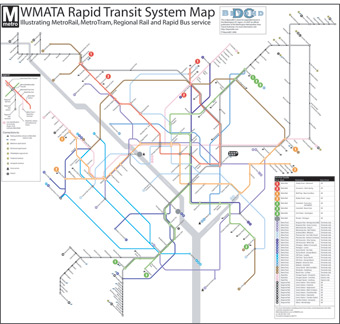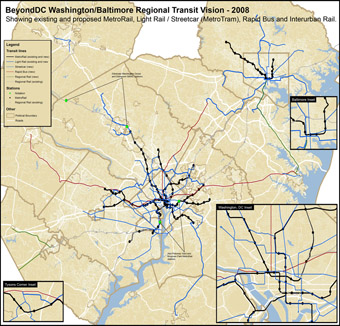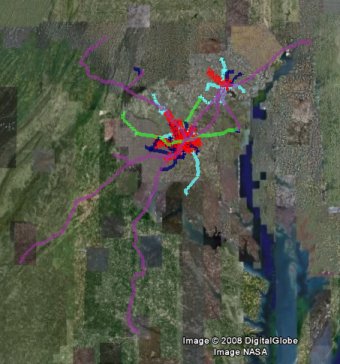|
This is not a fantasy. It is an achievable vision of transit expansion in the Washington region. The main assumption is that rather than spending billions on three or four MetroRail extensions, we could achieve far greater coverage and efficiency by recognizing that one size does not fit all, and matching the mode to the corridor. MetroRail, great as it is, is too expensive to build everywhere, and though MetroRail extensions to Woodbridge, Centreville and BWI might be wonderful in those individual corridors, for about the same cumulative cost we could have a far greater affect on regional travel by blanketing arterials inside the Beltway with light rail and upgrading our existing commuter rail infrastructure into true regional interurban lines, with weekend service, hourly trains, etc.
To be sure, we're proposing a lot of spending here. No doubt to the tune of ten figures. But the costs would be comparable to what Maryland, Virginia and the District are planning to spend on transportation over the next couple of decades anyway. Our plan is merely a reallocation.
For the record, BeyondDC doesn't mean to suggest that MetroRail isn't worth the money. Metro's effect on the Washington region has been nothing short of revolutionary; it has been worth every penny spent, many times over. Furthermore, streetcars alone would be incapable of providing all the rail transit necessary for a city as large and diverse as ours. This vision can only be taken within our regional context of 100 miles of existing MetroRail service. Indeed, where we think MetroRail is the best mode for a new route, such as between the Orange line and Tysons Corner, we've included it despite the cost. The point here is that given what we already have, streetcars and interurbans are the best capital investment we can make right now. After these lines are built it may once again make sense to build significantly more MetroRail.
A final note before getting into technical explanation: Making such hard decisions as MetroRail versus streetcars is only necessary in the first place because our country's transportation spending is wildly out of whack. Decades of widenings and new roads have brought our planet to the brink of disaster, ruined our cities, and taken our economy hostage, all with the result that congestion is far worse now than when we started. Like pre-industrial medicine focusing on bloodletting, highway engineering is junk science. The time, lives and money spent on it don't change the fact that it simply doesn't work. For all the arguments and numbers BeyondDC is throwing out contending that Metro isn't the most efficient use of our transportation dollars these days, anything given over to road or parking capacity is severely worse-spent. More MetroRail would be good; it's just that more streetcars would be better. More roads, in any event, would be utterly counterproductive.
Notes on MetroRail:
- When diagrams get as criss-crossed with lines as this, using a totally different color for every route just isn't feasible. Instead, it's common practice among providers with this kind of route density to illustrate trunk lines as a single color with multiple tails at the ends. Thus, rather than showing the Orange and Blue lines sharing a tunnel downtown, we've simply shown them both as Orange and used terminal markers to differentiate routes.
- The only new MetroRail line we've provided is the Tysons Corner spur. It's essentially the officially proposed Phase 1, except we've truncated the end and put the terminal station park and ride at Wolf Trap rather than Wiehle Avenue, and we've given the four Tysons Corner stations more unique names.
- There are two infill stations - at Potomac Yard in Alexandria and Kingman Park near RFK Stadium.
- To save the Rosslyn tunnel from overuse, we've routed all Alexandria-bound MetroRail trains north onto the Green line. To provide service between Rosslyn and the Pentagon we've supplied a Gray line shuttle. One train (or two) would simply go back and forth between Rosslyn and Pentagon all day. There are also two new streetcar crossings between Rosslyn and the District, partly for that reason.
Notes on Light Rail / Streetcars:
- All streetcar services are shades of blue or purple on the diagram. We used brown to differentiate "mini Metro" style light rail.
- Both streetcars and light rail are capable of running in their own right of way, on the street in a dedicated lane, on the street in mixed-traffic, in a subway, or elevated. Presumably most of these lines would be running in a dedicated street lane, but we haven't specified. In some cases (Georgetown?) there may not be enough room for a dedicated lane, and in others (the downtown roundabouts?) going over or under could make more sense than around.
Notes on Regional Rail:
- Because we hope MARC and VRE will one day provide at least hourly service at midday and on weekends in addition to their normal commuter operations, we're shying away from calling them "commuter rail".
- We haven't mentioned MARC or VRE by name on the maps because ideally they should be combined into a single provider.
- We removed two existing MARC stations in Montgomery County. Dickerson, because it's clearly not necessary to serve both Dickerson and Barnesville directly (MARC tried to remove them both last year), and Washington Grove, because multimodal service would be overkill at such a small station, and the Corridor Cities Transitway (Route I2) is proposed to have a light rail stop at that location.
- In addition to improving service on existing routes (see the MARC improvement plan), we've proposed the following extensions, all of which are under official consideration in one form or another, and all of which are along existing, functioning rail tracks: Perryville to Elkton (where MARC would connect to an extended SEPTA line between Delaware and Philadelphia), Martinsburg to Hagerstown, Manassas to Haymarket, Broad Run to Charlottesville, Fredericksburg to Richmond.
- The only new Regional Rail construction we are proposing is the Camden Station – Annapolis line. There is an existing right-of-way, where rail service once ran between the cities, but the tracks were torn out years ago. We didn't provide a rail connection between Washington and Annapolis because Bus Rapid Transit would be easier in that corridor (see below).
Notes on Rapid Bus:
- Generally speaking BeyondDC is in favor of BRT only as a way to improve bus routes, not as a replacement for rail. But we're not ideologues about it. Sometimes BRT just makes more sense. BRT can be particularly useful when you want to provide long-distance express service along corridors where there is an existing highway, and where new rail would have to be purpose built (as opposed to running trains along freight tracks). Since BRT has lower capacity than rail, it can also be useful in suburban or inter-city corridors, where passenger traffic is lower than in the central city.
- We've only shown BRT routes that could be characterized as "express" service. Neither of the maps illustrates "limited" services such as MetroExtra, though presumably such services will continue to exist, and be expanded.
- Along those BRT lines that we show, we've only marked "express" in-line stations. On-street stops in the center city aren't illustrated (as they aren't for streetcars).
Notes on the cost of modes:
Any attempt to cost this system out to more than a ballpark figure would be highly speculatory on our part, but to get a general sense of the costs involved we can compare the known figures for the Tysons Corner / Dulles (Silver line) MetroRail and the Columbia Pike streetcar proposals.
The Virginia Department of Rail and Public Transportation estimates that Phase 1 of the Silver line (the portion from East Falls Church to Wiehle Ave) will cost $2.1 billion for 11.6 miles and 5 stations. Phase 2 is estimated to cost $3 billion for 11.5 miles and 6 stations. Averaged out that corresponds to a Phase 2 cost per mile of $261 million, or $223 million per mile for the entire Silver line.
According to Arlington County, the Columbia Pike streetcar is estimated to cost $140 million for 5.2 miles and several stations. That is, the entire line can be built for approximately half the money it will take to build a single mile of Silver line. Per mile, the streetcar will cost $27 million – approximately 10% the cost of a mile on Silver line Phase 2.
Broken down per anticipated rider:
Silver line:
$5.1 billion divided by 91,200 anticipated daily riders = $55,921 per rider.
Columbia Pike:
$140 million divided by 21,000 anticipated daily riders = $6,666 per rider.
The streetcar is literally eight times as fiscally efficient.
If Virginia were to build the truncated Tysons line as we've proposed, ending at Wolf Trap rather than Loudoun County, that would free up enough money to build about 120 miles of streetcar. If we can get ridership on all 120 miles that's similar to what we're getting on Columbia Pike (21,000 riders / 5.2 miles = ~ 4,000 riders per mile = 480,000 riders for 120 miles), that's many times more efficient at producing transit riders than the Silver line. Even if we don't get so much as half Columbia Pike efficiency on other streetcar routes, we'd still be doing far better than the western segment of the Silver line.
It's numbers like these that have BeyondDC convinced that more streetcars are a better investment than more MetroRail.
Other notes:
- The Transportation Planning Board Constrained Long Range Plan is the closest our region comes to an official, unifying transportation plan. It's considerably more restrictive than what BeyondDC is showing.
- The Maryland Transit Administration has prepared a visionary Baltimore Region Rail System Plan that is comparable in scope to BeyondDC's vision. What we show is influenced by MTA's plan, but takes liberties where we think appropriate.
- We didn't give a whole lot of thought to where ferry connections would be, and have no idea how much ferries cost. We included that aspect merely to illustrate the possibility of water taxi service.
- Thanks to Greater Greater Washington for lighting BeyondDC's fire on this. We'd been planning on doing something like it for a long time, but it was GGR's transit future maps that convinced us it was time to get going.
- For alternate, more official streetcar scenarios, go here and here.
- On May 2, 2008 Washington Post columnist Marc Fisher wrote about this vision.
- The geographic map was created using ArcMap 9.2. The diagram was created in Adobe Illustrator CS2.
|
Click maps for larger versions.



|


